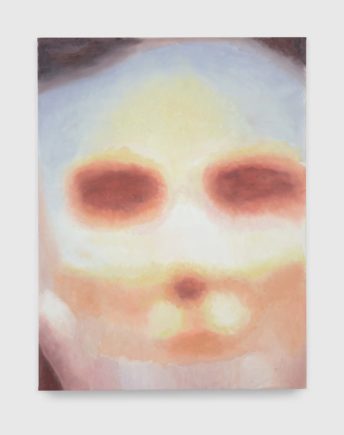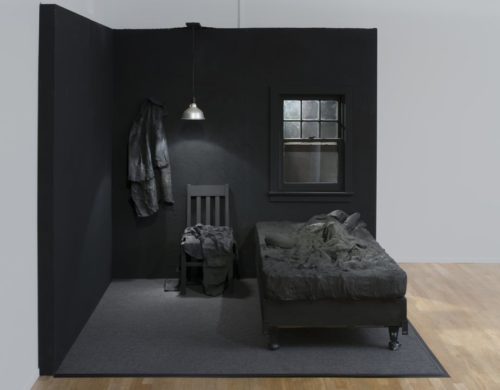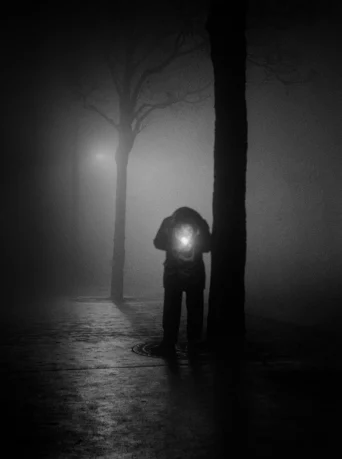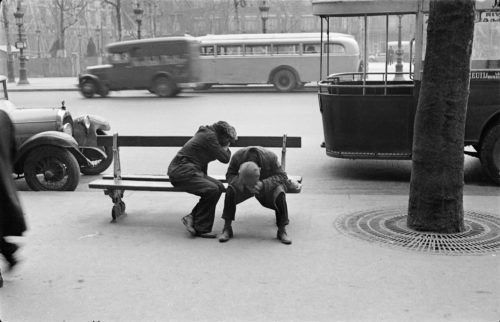
Mario Schifano
“It is quite unimportant what we play with as long as we play, and people who cannot play, who long for unobtainable playthings instead of making a living doll from a handkerchief, are rather stupid.”
Georg Groddeck (Letter to Sandor Ferenczi)
“In the moment of trauma, children instinctively submit and comply with what abusers want—not just in behavior but in their perceptions, thoughts, and emotions—in order to survive the assault; afterwards they often continue to comply, out of fear that the family will turn its back on them. Notably, a persistent tendency to identify with the aggressor is also typical in children who have been emotionally abandoned by narcissistically self-preoccupied parents, even when there has not been gross trauma.”
Jay Frankel (The Narcissistic Dynamics of Submission,The American Journal of Psychoanalysis,2022)
“An unconscious relationship is more powerful than a conscious one.”
Soren Kierkegaard (Sickness Unto Death)
“I cannot resist telling you that my eyes were opened to the dubious nature of this concept of positivity only in emigration, where people found themselves under pressure from the society around them and had to adapt to very extreme circumstances. In order to succeed in this process of adaptation, in order to do justice to what they were forced to do, you would hear them say, by way of encouragement—and you could see the effort it cost them to identify with the aggressor—’Yes, so-and-so is really very positive’.”
Theodor Adorno ( Lectures on negative dialectics: Fragments of a lecture course 1965/66)
“I realized that I was dreaming; with a vast effort I woke myself. But waking up was useless—I was suffocated by the countless sand. Someone said to me:
You have wakened not out of sleep, but into a prior dream, and that dream lies within another, and so on, to infinity, which is the number of the grains of sand. “
Jorge Luis Bórges (The Writing of God)
Both Georg Groddeck and Sandor Ferenczi are remarkably neglected. It is even hard to find a copy of Groddeck’s most famous book, “It” (which was badly translated sixty years ago and never revised). Ferenczi is not much better. It is an interesting question as to why this neglect has so lingered. Other than most of the radical inner circle around Freud, nearly all with leftist leanings, are also, to lesser degrees, neglected, too. The existing biographical studies of Freud’s original Vienna group are all pretty facile and largely without anything remotely like an either political or philosophical import. Groddeck later in life claimed Freud had stolen the idea of the Id from him. Certainly Groddeck’s *it* resembles the Id, but its markedly different, too. Groddeck reminds one of Wilhelm Reich at times because of his basic sense of the sickness of humanity. The contemporary world would seem to suggest both were right.
“Long before I met the above-mentioned patient in 1909 I had become convinced that the distinction between body and mind is only verbal and not essential, that body and mind are one unit, that they contain an It, a force which lives us while we believe we are living.”
Georg Groddeck (The Meaning of Illness)

Lucian Freud (1944)
It was Ferenczi who first used the term ‘identification with the aggressor’. Later I believe Anna Freud and then Melanie Klein used it. But Ferenczi, as Jay Frankel notes, was suggesting the preoccupied parent was a special category of neglect. One might see today’s screen preoccupied parents as exemplars of this but in an intensified version. Three generations of narcissistic parenting has led to the current state of youth in the West so often siding with the state, with influencers and celebrities and with power in general. Cutting across this is the rise of cynicism that I have spoken of before. Cynical and snarky subject positions are certainly the norm on social media.
Groddeck was deeply insistent that symbolic meanings for illnesses contribute greatly to how they present and also how the patient treats recovery. Sickness was a narrative.
“…some of the ideas he developed in his seminal `Psychic Conditioning and the Psychoanalytic Treatment of Organic Disorders’, published in German in 1917, which may be considered as the foundation of modern psychosomatic medicine. In this text, Groddeck proposed that all diseases contain symbolic meanings which need to be unveiled in order to bring about mental and physical transformation. He held that unconscious processes determine how susceptible we are to diseases, the nature of these diseases, and the conditions for our recovery.”
Lazslo Antonio Avila (Georg Groddeck; Originality and Exclusion)
This will take us back to language eventually, but reinforces my belief in the importance of allegory in contemporary life, where, on the surface anyway, allegory doesn’t exist (or, perhaps that everything is allegorical). I tried this week to, again, read Stanley Cavell. It’s impossible. Honestly, from whence comes his reputation? His writing on film is embarrassing. He is slightly more readable on Wittgenstein, but still largely repeating the work of other philosophers. Has Cavell ever had an original thought in his life? I ask sincerely. Now I mention this because I was thinking a bit about the first artists I fell in love with, about the time I started Junior High. As a child I had a print of Goya’s Bullfight in a Divided Ring on my wall. I can’t remember how it got there but it fascinated me for years. Later my parents bought me a Joan Miro print. But in Junior High I discovered modern abstract art. De Kooning was my first passionate love. And it was the painting I post here. Perhaps it was that extraordinary pink. But I read everything I could on DeKooning and then Pollock and Rothko and Kline. In high school I became infatuated with local painters, homies like Ron Davis and Diebenkorn. And then Barnett Newman. I don’t know what it was about Newman exactly. He is often singled out by the philistine public to demonstrate modernism is a joke (oh hell, I could do that, Im in the wrong business, etc). Interestingly Newman is the artist most subjected to vandalism of any in the 20th century. I take this as a kind of badge of honour. But like with Pollock, if you sit in person in a room of their paintings, Newman and Pollock, more than any others for me, there is still to this day a sense of wonder and almost something thrilling.
Throughout all this I would return to Giotto and Goya again, and to Michelangelo and Donatello. Nothing all that unusual in this journey. And my discovery of film, at least as an art, came a bit later. In my early twenties. What is striking about Cavell is that his interest in film begins and ends with Hollywood. He has no particular take on *genre* or on the politics of the industry. Compare Franco Moretti on popular art, just off the top of my head. But the point is, perhaps, that academic philosophers such as Cavell are strangely insular and narrow in their interests. This is how I have always felt about logical positivism, too. It’s not how I feel about Wittgenstein, and therein lies a discussion.

Barnett Newman (Canto I 1963 )
But before that, I want to return to Ferenczi and Freud. But perhaps it would be most fruitful to delve directly into Freud, rather than those writing about him (of which I am guilty, too often).
“To put it once more, in a different way: psycho-analysis cannot situate the essence of the psychical in consciousness, but is obliged to regard consciousness as a quality of the psychical, which may be present in addition to other qualities or may be absent.”
Sigmund Freud (The Ego and the Id)
This is from the opening chapter. In some ways, this is the book I would suggest people begin with if they are looking to read Freud. The other, and maybe more reasonable, would be The Interpretation of Dreams. But then I think one should read all of Freud. I probably have read at least 90% of his complete works. Some more than once.
“But we have arrived at the term or concept of the unconscious along another path, by considering certain experiences in which mental dynamics play a part. We have found-that is, we have been obliged to assume-that very powerful mental processes or ideas exist {and here a quantitative or economic factor comes into question for the first time) which can produce all the effects in mental life that ordinary ideas do (including effects that can in their turn become conscious as ideas), though they themselves do not become conscious. It is unnecessary to repeat in detail here what has been explained so often before. It is enough to say that at this point psycho-analytic theory steps in and asserts that the reason why such ideas cannot become conscious is that a certain force opposes them, that otherwise they could become conscious, and that it would then be apparent how little they differ from other elements which are admittedly psychical. The fact that in the technique of psycho-analysis a means has been found by which the opposing force can be removed and the ideas in question made conscious renders this theory irrefutable. The state in which the ideas existed before being made conscious is called by us repression, and we assert that the force which instituted the repression and it is perceived as resistance during the work of analysis.”
Sigmund Freud (Ibid)

Luc Tuymans
Two things strike me here, the first is, and Freud notes this, the idea of an unconscious is going to fly in the face of certain empirical science since it cannot be weighed or measured. The second thing is that while many people today will dismiss Freud as outdated, as unscientific, as a pseudo science or pseudo philosophy, they all actually use Freudian concepts in their thinking. They make uncredited reference to Freud every day. The third reaction I run up against is that which claims there is nothing new in Freud. And in one sense, this is at least partly true. From the ancient Greeks onward thinkers have recognized there is a latent part of the psyche. This in no way diminishes what Freud accomplished. Nor does it mediate at all the profundity of his work. Freud made clear there were two forms of unconscious, or two aspects. One which was latent but capable of becoming conscious, and one was not capable of becoming conscious. The latent unconscious Freud came to refer to as preconscious. Also…
“We recognize that the Ucs. does not coincide with the repressed; it is still true that all that is repressed is Ucs., but not all that is Ucs. is repressed.”
Sigmund Freud (Ibid)
Freud also crucially postulated what was in essence a third unconscious — an unconscious, or a part of the unconscious that was not repressed. This is something that he would tentatively return to throughout his life.
It is here that Freud suggests a spatial aspect of his theory. The Ego, or consciousness, is the surface. It is directly related to sensory input. It is closest to the material world. Both functionally and anatomically, it is first. And he makes clear there are inherent problems with this spatial model of the mental apparatus.
The idea is, then, that however one wants to describe this process of becoming preconscious (via trace memories, for example, which is a convoluted logic that attempts to explain the distinctions between hallucinations and a revived memory. Freud argues that verbal residues are from auditory perceptions, and hence the preconscious has a special sensory source. Visual components of word presentations are secondary (!)). The germane point here is that visual thinking, or thinking in pictures, is a very incomplete way for residues coming to consciousness.Freud also suggests, somewhat hesitantly, that this thinking in pictures is an older process than thinking in words, and one closer to the unconscious. Whether this is true or not, I think, is an open question. It also begs questions of Jungian theory, but more on that later. It also, most significantly, begs the question what exactly is meant by *old*.

Willem DeKooning (1955)
Without going through all this step by step, the next note worth mentioning regards resistance. The Ego will not notice a deeply buried impulse. Sensations of pleasure take care of themselves, while unpleasure, or something (Freud’s word) that is not unlike unpleasure, becomes meaningful only when it meets resistance.
“Not until there is resistance to the compulsion, a hold-up in the discharge-reaction, does the ‘something’ at once become
conscious as unpleasure.”
Sigmund Freud (Ibid)
Feelings are either conscious or unconscious. The pre-conscious is not relevant here.
“The part played by word-presentations now becomes perfectly clear. By their interposition internal thought-processes are made into perceptions. It is like a demonstration of the theorem that all knowledge has its origin in external perception. When a hypercathexis of the process of thinking takes place, thoughts are actually perceived-as if they came from without-and are consequently held to be true.”
Sigmund Freud (Ibid)
And it is at this point Groddeck enters the picture:
“Now I think we shall gain a great deal by following the suggestion of a writer who, from personal motives, vainly asserts that he has nothing to do with the rigours of pure science. I am speaking of Georg Groddeck, who is never tired of insisting that what we call our ego behaves essentially passively in life, and that, as he expresses it, we are ‘lived’ by unknown and uncontrollable forces. We have all had impressions of the same kind, even though they may not have overwhelmed us to the exclusion of all others, and we need feel no hesitation in finding a place for Groddeck’s discovery in the structure of science. I propose to take it into account by calling the entity which starts out from the system Pcpt. and begins by being Pcs. the ‘ego’, and by following Groddeck in calling the other part of the mind, into which this entity extends and which behaves as though it were Ucs., the ‘id’.”
Sigmund Freud (Ibid)

John Vachon, photography (worker, General Electric, 1940s)
This idea of being lived, rather than living, finds parallels in early religious writings, of both East and West, and in the developmental theories of infants by psychoanalysts like Melanie Klein. That the deepest (sic) reaches of the psyche contain some quality of disassociation feels correct, at least partly. One cannot avoid the paradoxes of consciousness. But there is also the question of dreaming. James S. Grotstein , who died only a few years ago, was an LA based psychoanalyst and while a student of Bion and Melanie Klein, he also wrote a somewhat surprisingly unusual book Who Is the Dreamer, Who Dreams the Dream? A Study of Psychic Presences. I say unusual because it is a decidedly unAcademic study. It feels more like what early psychoanalysts from the dawn of the 20th century might have written.
“There is a vast difference, for instance, between thinking of an ego, on one hand, and of accepting “I” as the consummate, complex, nonlinear, multidimensional subject, on the other-or between using the construct of the id as opposed to Lacan’s (1966) “Other,” which I sometimes render as the “second self” or “alter ego” or the “ineffable subject of the unconscious.” When the ineffable subject of the unconscious finds an external other who happens to be a psychoanalyst, then the two together constitute what the Greeks called the psychopomp, the conductor to the realm of lost souls. “
James S. Grotstein (Who is the Dreamer who Dreams the Dream?)
I have written before about a process I called ‘re-narrating’. I believe this is what we, all of us, do when reading anything. Perhaps not an Ikea manual, but almost everything else. Certainly in novels, and in fact the novel may be the logical outcome of the evolution and development of this psychological process. That at a certain stage of psychic development, an aspect of the cathexis becomes extended narrative writing. It may be that early humans, as they developed an alphabet and coordinated language, and by extension a process of reading, that this process had an internal correlate of silent reading. And this silent reading, which maybe began during oral recitation, was a way to comment on the *story* as you read it.
And it is possible that this re-narration came before complicated syntactical writing and was a part of the growth of the rules of grammar. The point here has more to do with dreams and our desire to re-narrate. (and one of the problems with today’s entertainment product and its reduced narrative complexity is an unconscious frustration there is no structure sufficient to hold re-narration). And dreams seem almost (per Grotstein) to exist regardless of our wants. Or they are pure expressions *of* want.

Harry Gruyaert, photography (Antwerp. 1988)
We dream whether we like it or not. And I think Grotstein (and others) are correct regards dreams, but I don’t think this negates Freud (nor does Grotstein). One would be hard pressed to find a single culture or society that does not have an elaborate interpretive dream theory. Native Americans, the Pharaohonic Egyptians, ancient Greek and etc – all had deeply entrenched rituals and behavior to deal with dreams. And as Grotstein notes, there is another dream thread that is seen repeatedly in various historical locals, and that is the idea of a ‘stranger within’. There is the stranger or *double* as well, but I refer to the dream stranger. Or, often, the dream ‘as’ stranger within. There is the stranger in the dream narrative, and there is the dream AS a strange presence *inside* ourselves. (See Gnostic teaching on Godhead, god-within etc).
“I posit that the unconscious is perhaps as close to the “God experience” as mankind can ever hope to achieve. Bion (1965, 1970, 1992) informs us that the Godhead is utterly ineffable and beyond contemplation and equates it with Absolute Truth, Ultimate Reality, the noumenon, beta elements (unmentalized elements), the thing-in-itself.The experience of a presence that is meta-human or preternatura exists as a potentiality in the boundless landscape of the unconscious. I believe that it is here that religious, philosophical, and mystical studies converge with the psychological and the psychoanalytic.”
James S. Grotstein (Ibid)
As an almost side bar here, I think one would be hard pressed to find a creative writing class or program, from MFA to community adult school, in which some of the instructions will go along the lines of ‘find that real voice inside you’, etc etc etc etc. So, the idea of presences inside (sic) us it both a sort of folkloric belief for most people, but also a topic that seems with some regularity to reappear in scientific tracts or journals.
“Transcendentally speaking, the object the infant encounters is not merely a realistic object. That is, it is apperceived (anticipated) by virtue of inherent categories and a priori considerations (including needs, drives, affects, expectations, etc.), all exported by projective identification, which transforms the image of the real object into a phantom (even during moments of extreme trauma). This phantom becomes a compounded, or third, form, a montage, a chimera (hybrid, containing many disparate forms), which ultimately becomes far removed in nature and composition from the original object in reality. { } My term psychic presences is meant to convey the experience of intrapsychic preternatural entities, which present as images or phantoms and which we, in turn, reify as real. These images or phantoms undergo a transfiguration or transmogrification as we progress from the paranoid-schizoid to the depressive position, to use Kleinian terms and concepts. They evolve into symbolic images that designate the “presence of the absence” of the object-person, that is, the presence of the legacy of the experience with the object in its absence. “
James S. Grotstein (Ibid)

Pierre Puvis de Chavannes (Portrait of a Woman in Profile, 1857)
Grotstein interestingly draws on Bion and Klein, his primary influences (besides Freud) but also on Rene Girard and his idea of *mimesis*. This is the topic I have written about repeatedly over the last two years. And Grotstein also notes how much theological writing is concerned with exactly this. But this is a language and approach to the mystery of existence that has largely fallen from favour. And science is explicitly not interested in authentic or inauthentic presences, if they even entertain the idea of presences.
“I have come to realize that what we have been calling internal objects are really “third forms,” chimerical (hybrid) conglomerations of the image of the real object image intermixed with the resulting products from splitting and projective identifications of aspects of the subject.”
James S. Grotstein (Ibid)
This is the crux of things. Perception is an apperception. What we are seeing (sic) is what we are (per Grotstein) predisposed to see. But in what was does this predisposition occur? What does that mean? Well for Grotstein there is a continuous formatting of sensory input.
“What have become known as internal objects are, to my thinking, “rogue” or “renegade subjects” ensconced within images of objects. In other words, the agent of intentionality or will of internal objects is always a function of split-off subjects. As Ogden (1986) reminds us, “Internal objects do not think.” These internal objects express themselves clinically as primitive, compulsive, relentless superegos, uncontrollable, omnipotent, sometimes impulsive (even addictive) subjective objects, or as defective, wounded, or impotent object relics with which we identify.”
James S. Grotstein (Ibid)
One immediately sees the problem. These *objects*, says Grotstein, express themselves (clinically) as ….etc. But this feels like a dodge, in a sense. They are not *expressing* anything. They are, we can agree, formatting this wider picture, or landscape, that constitutes the world in which we (sic) live. However these transformations take place, there are very deep questions attached to every attempted explanation. Freud quoted Kant more than once. For he knew (as does Grotstein) that Kant’s apriori categories algin closely to the Freudian unconscious. The non repressed unconscious is unknowable. From a Kantian perspective they are transcendental. There is more here, that I want to return to, in another post perhaps…

George Segal (1995)
but the key paragraph is this:
“I reason from these citations of Freud that he conceived of the Ucs. as both wantonly discharging in its relentless search for pleasure and relief from unpleasure and paradoxically protective of the psyche by actively withholding cathexes from becoming discharged-out of consideration for the psyche. As I shall try to show in the following chapters, I believe that the discharging Ucs. is not only obeying the ongoing needs of the individual, but also is “discharging” in order to get the attention of the psyche-in dramatic form-of urgent affects and affect scenarios that need to be recognized and processed. On the other hand, the Ucs. that retains its cathexis from discharging does so out of a “cooperative” covenant with the psyche to protect it from too much revelation achieved too quickly.”
James S. Grotstein (Ibid)
The transcendental unconscious, in this metaphor, wants (!) attention. Putting aside the desire, one has to ask what is so urgent, as it were. The discharge is the Ur-theatre of the mind. Benjamin, when writing of Kafka, came close to this sort of idea; the *scheme* of the primal trauma is the stage. The theatre, and perhaps all creative action, is the need for a stage. A site on which this discharge asks to be recognized. The unknowable transcendent creates space, then, when discharge must have a *place* to discharge — the dream is necessary for, it seems, several reasons; it links past and present (and future?) and it releases the tension of what cannot be understood or reconciled or accepted, and it is the precondition for Being. And is consciousness the same as Being (phenomenologically speaking)? I wrote in the last couple posts about what I had to call a *turning away*. That in both a literal and an allegorical sense, human consciousness blinked — could not face whatever it was, the face of God I suppose. Certainly many religious traditions have versions of this. The energetic discharge is both wanton and arbitrary, and is somehow self concerned. This is the logical cul de sac. For here the bodily issues, the senses, intersect with these metaphors and topologies. Our consciousness is there because of some kind of energetic discharge that is necessary, is a cry for recognition, and is the god-like creator of *space*. This recognition is how the infant, then, begins to know it is *something*, and not nothing. Not just a mushy pleasurable suckling machine.
And here one must ask what are dreams? Grotstein writes of a dream he had after his mother’s heart attack. Since my heart stoppage, three weeks ago now, I have had very vivid dreams, and dreams that I remember upon waking. I have not remembered dreams much for the last fifty years, so this is a bit unusual. They are not frightening, or threatening. They are calm dreams. Strange, to be sure, but a bit like a Bresson film, or maybe a Dryer. They have made me ponder from whence comes dreams at all. And Grotstein spends a good deal of time on this, quoting Samuel Lowy, a Czech neuropsychiatrist, from a book Lowy wrote in 1942.
“By means of the dream-formation, details of the past are continually reintroduced into consciousness, are thus prevented from sinking into such depths that they cannot be recovered. Those of our experiences which are not at the moment accessible to consciousness are thus kept in touch with consciousness, so that in case of necessity association with them may become easier.”
Samuel Lowy (Psychological and Biological Foundations of Dream Interpretation)

Sabine Weiss, photography.
Dreams as a mechanism to link the past with the present. Grotstein recounts the dream he had at medical school. And what he remembered most, even today, was the beauty and inspired narrative architecture of the dream. And he asked himself *who wrote it?* Of course most writers have had the experience of writing on late into the night and then waking and reading what they had been working on — and not recognizing it. I have this happen numerous times. Literally, having no memory of writing it. Often what I think of as my best work was work I later did not recognize. There are many reasons one could come up with. The most obvious is that one would not allow oneself to write certain things if fully conscious. I had that experience writing a character I later realized was my father.
“As I continued my inquiry into the mystique of the dream, I began to wonder about another member of the theater group, the audience. Freud believed that dreams are nighttime visualizations of wish fulfillments. In my analytic training I accepted that concept until I discovered the object relations theories of Fairbairn and Klein. Even if Freud was right, I began to wonder, who discharges the tension? In other words, who watches the dream to know that it is fulfilling a wish, particularly if the dreamer is asleep? { } I reasoned that there must be something like an unseen audience in the dream who observes the play, experiences its truths and its messages, and renders an approval that vouch- safes the continuation of sleep. It dawned on me that the dream acts…{ } both as an evacuation of the residual daytime tension that threatens our transient escape into sleep and as a reworking of these nighttime accretions of mental stimuli, which become rearranged as narrative, dramatized in theatrical form, and relayed communicatively to an audience who experiences dramatic communication in such a way as to experience relief. Now the held over cares of the day can be put to sleep. The dream is therapy presented in a dramatic form according to special rules!
This audience, I reasoned, must be literate, articulate, and theater-wise. Moreover, it must be a most particular critic and have some hidden knowledge of the rules of human drama and narrative.”
James S. Grotstein (Ibid)

Samuel van Hoogstraten (1664)
In this theory there is still the Freudian idea of dreams as wish fulfillments, but also dreams as sort of conflict janitors. So there is both a writer (and producer) of the dream, as well as an audience for the dream. And Grotstein spends a lot of time trying to tweeze apart this composite set of selves, or presences, in our psyche. But the buck must stop somewhere. And that place is always the unknowable transcendental unconscious. However one wants to label it. And this is both the origin of who and what we are, our *I-ness* , and the beginnings of religion. So when I suggest that religion comes out of theatre, this is more or less what I mean. For our dreams happen, we experience them, and even the most scientific neurobiological theories can take us no further. The theatrical (or filmic) metaphors Grotstein employs can be pushed very far (and he does), but they do have some relevance to the idea of psychosis. The psychotic dreams what the internal audience cannot understand. Psychosis is a disruption of various parts of this process. And when considering this it becomes clear just how fragile is our sense of self. In much Eastern thinking (well in Hindu scripture certainly) the idea of dreams that speak a foreign language, a language of the Deities, leads one to the precipice of the schizophrenic and many of Laing’s insights. The schizoid’s internal Google Translate has a glitch.
“The unsuccessful dream, the nightmare, can be seen as a rent in the symmetry of Perfect Truth. A war between “I” and Self-that is, a war between different aspects of the Background Presence of Primary Identification, the bastion of trust and truth-now seems to undermine the dreamer. If the background presence appears to have been damaged, the dreamer’s dreams seem to be too malevolently oracular. The back- ground presence then corresponds to what I have called the experience of the “magus object,” that is, one whose language is mysterious, deceptive, and foreboding. { }Freud (1900) said that day residues in the preconscious psychic system are purloined by the instincts, which, like devils, constantly seek human form in order to materialize (the metaphor is mine, not Freud’s). In so doing, the instincts effectively offer these day-residue experiences the protection of the repressive barrier. “
James S. Grotstein (Ibid)
Ah, resistance. Repression. One can immediately see the fragility, too, of metaphors at this point. It is to Freud’s credit, and a testament to his genius, that he grasped the problems of his own metaphors. He showed enormous restraint, in fact, vis a vis metaphors. And one can see, too, in Roheim, in Ferenczi and later in Jung, that all of them were cognisant that their work would eventually take them to the threshold of mysticism. Now Grotstein devotes a chapter, a short one, to the *actors* in the dream. But I think there are problems in his understanding of acting. And one of the truths of the theatrical process is connected to repetition, as I have written about before (several times).
https://john-steppling.com/2021/05/checkpoints-on-the-frontier-of-desire/
I quote from Deleuze:
“The repetition of dissymmetry is hidden within symmetrical ensembles or effects; a repetition of distinctive points underneath that of ordinary points; and everywhere the Other in the repetition of the Same. This is the secret, the most profound repetition: it alone provides the principle of the other one, the reason for the blockage of concepts. In this domain, as in Sartor Resartus, it is the masked, the disguised or the costumed which turns out to be the truth of the uncovered.”
Gilles Deleuze (Repetition and Difference)

Wily Ronis (Photography)
and from Norman O. Brown:
“Psychoanalysis began as a further advance of civilized (scientific) objectivity; to expose remnants of primitive participation, to eliminate them; studying the world of dreams, of primitive magic, of madness, but not participating in dreams or magic, or madness. But the outcome of psychoanalysis is the discovery that magic and madness are everywhere, and dreams is what we are made of. The goal cannot be the elimination of magical thinking, or madness; the goal can only be conscious magic, or conscious madness; conscious mastery of these fires. And dreaming while awake.”
Norman O. Brown (Love’s Body)
And this is particularly relevant here. I noted the obvious ways the Covid propaganda story was built from myth, metaphor, and science (manipulated fraudulent science) in about equal parts. Now I have spent so much time on Grotstein’s book because I think it lays out the scenic design for the basic extensions of Freudian dream theory. But back to actors for a moment. If dreams are necessary, part of psychic discharge, and if this process is the origin of stage-space, then actors are necessary, too. The playwright is always writing himself, certainly, as part of a complex mimetic dialectic that implies ‘the actor’. The voice of memorized text — this fact is hardly ever investigated for some reason. But the voice of repetition is key to what Grotstein envisions as the Dreamer who dreams the dream. The audience (any audience) knows it is watching (sic) a play, and knows the lines are memorized and written by someone NOT the actor. It has always struck me this has rather vast implications.
“It is all psychodrama. The symptom is a dramatized wish; neurosis endows reality with a special meaning and a secret significance.” Norman O. Brown (Ibid)
Our composite presences, the acting troupe in our psyche, is also not just ours. It is collective. The audience knows the story, or parts of it, and likely his grandparents knew it, too. The society itself knows these stories. I suspect tragedy disappeared when this fact was forgotten. In Roheim, and Eliade, and in Ferenczi … the role of the collective was a part of their theory. And this is very tricky territory, for it lends itself to the ahistoricism that reached extremes with Jung. This is paradoxical, for there are arguments to be made, even for Jung, that he was TOO focused on history, albeit a reductive idea of history.
“Thus names and personalities are fixed by archetypal persons and situations; the voices coming through the masks are always ancestral voices. The masquerade or carnival is a danse macabre, a visit of ancestral spirits, represented by the authorized bearers of their persons. The life of the clan consists in the perpetual reincarnation of ancestors—a reincarnation achieved by magic, by imi- tation (identification), by dramatic representation.”
Norman O. Brown (Ibid: Cf. Eliade, The Myth of the Eternal Return, ch. I.)
For Capitalism to be effective, individuality must be constantly reiterated. Marketing emphasises *individuality* in everything. But this is a particular form of individuality. This is, in a sense, the psychotic individual — the dreamer of unreconcilable dreams. I suspect that human brains have now been additionally damaged by the screen/smartphone/internet. The rugged American individualist is more about an anti-collectivist self than it is about anything to do with this self. And understanding this provides a good deal of clarity about the evolution of US society in terms of culture and art.

Carla Klein
I return for a moment to Grotstein…
“This Background Presence evolves from being a co participant in the mysterious oneness of primary identification to being a released and backwardly departing soul or spirit of comforting protection; it is ultimately felt as a religious, spiritual, or divine essence or a sense of tradition and background certainty. All this takes place as infants accept separation and find the confidence to use their epistemophilic capacities (designated as K by Bion) in conjunction with libidinal organization (Bion’s L) and their inherent, undifferentiated defense organization, sometimes known as the aggressive drive or the death instinct, H.”
James S. Grotstein (Ibid)
This is important — this idea of a background presence (it is not unrelated to Merleau-Ponty and Heidegger both). It is convenient to use this metaphor and not identify it AS a metaphor. But I understand why its used. Grotstein even says….“The Background Presence of Primary Identification is the phantasied and mythical counterpart to Erikson’s (1959) concept of epigenesis and the sense of tradition that spawn each individual, the continuity of the sense of cultural or racial identity that ultimately devolves into the individual’s personal background. We feel a sense of comfort that someone stands behind us in our effort to face the world.” This is also close to Jung, again. And it carries that vaguely fascistic mythos (Erkison and Heidegger and Jung) that is dangerously close (or identical) with a racialized thinking of ancestral inheritance. And that Erikson wrote this at the end of the 50s is not an accident. As Nazism was being dispersed and sort of hidden away (in high ranking NATO jobs, or in US laboratories) the white supremacism lived on in philosophy and psychology departments in American academia.

Unknown artist, Ethiopia, early 16th century (presumed depiction of Saints James and Jacob)
This background serves the dream narrative. And it does this, it is posited, by a kind of deep structural capacity for the transformation of symbols (Chomsky et al). I have always thought this kicked the can down a road a bit. Contemporary neuropsychologists suggest (quoting Grotstein) “than a communicating apparatus in which neurons are busily engaged in rapid, computerlike informational sorties between one another which establish a continuing informational network acting as a single unit.” In other words, our psyche functions like a computer. Its nonsense of course and the tell is that word *information*. Its pure tautology, too. Informational sorties (sic) as if information had no other content or purpose or meaning. An informational network, I would argue, is a meaningless phrase.
I am not going to go into much of the rest of Grotstein’s chapter on this internal theatre of the mind, except to say I think there is a basic confusion. If, as many psychoanalysts (Kleinian in particular) see the face of the Mother was a screen on which dreams are projected, I would only ask if the maternal needs become a screen (or a stage)? It is already everything else, in a sense. It is again a metaphor, though, and that should be remembered. The primary caregiver is also our voice, is also the empty stage (no matter how much decor is added) and the ubiquitous figure of the exile or stranger that enters that stage. The exile is, of course, in search of the Mother.
But I wanted to return, at this point, to the idea of the identification with the aggressor. Gandesha here is referring to two accounts, both inadequate (Habermas and Kouvelakis), of how this is happening…
“What appears to be lacking in both these accounts of the crisis is the recognition of the need for an explanation of the growth of a palpable susceptibility among subjects to authoritarian rather than radically democratic solutions to the crisis of the capitalist social order that ultimately threatens liberal democracy not from the outside but from within (Adorno, 1998). So: is the crisis simply one of politics and ideology? Is it a crisis simply of failedor incomplete institutionalization? Or is the crisis deeper than this and is it one that has to do with the formation of democratic subjectivity itself?”
Samir Gandesha (Identifying with the aggressor: From the authoritarian to neoliberal personality)
As Adorno and Horkheimer said…“But anything natural which has not been absorbed into utility by passing through the cleansing channels of conceptual order” (Dialectic of Enlightenment) will be experienced as disruptive, if not, abnormal and unwholesome. Gandesha (who is very worth reading I think) notes how neoliberalism (quoting some of Paul Verhaeghe) seems to favor certain psychological types. Such qualities as superficial articulateness, duplicity, and mendacity, and reckless, risk-taking behavior. I would add the deeper reading here (while all these qualities are true) has to do with the infant-trauma that ignores the child, abandoning the return look of affirmation, and a focus on this sociopathic individuality as this damaged child matures. The damage begins with the transcendental unconscious and its cathexis. The drama of *I-ness* becomes an incoherent sit-com written in a language nobody knows. And I say sit-com because I think there is even a laugh track (or, ok, sound track) that accompanies today’s dreamer. Perhaps a laugh track without laughter.
The sentimentality of marketing is the bridge to the imprimatur of cruelty — state sanctioned cruelty is now applauded and passed on to the children of these indoctrinated adult-children.

Luciano Caprile
The effortless assimilation of former high ranking Nazis into western society (Von Braun was the face of Disneyland’s Tomorrowland) speaks to conditioned inclination to see aggression as appealing. And the dictator is just the rugged individualist in a political context. A gunslinger in the boardroom. This is, after all, what Gordon Gecko was. Mussolini emphasized a virility of the regressive erotic sadist (but boyish), which has now moved on to the strange dialectic of impotence as wisdom, albeit a mediated idea of wisdom (Bill Gates) or puer eternis as wanton fantasist (Musk or Trudeau), or simply senility (Biden, Stoltenberg, Trump). They all cross pollinate, too. Most of the leaders of the West today are like third generation dupes in terms of basic qualities of humanness. It is very hard not to compare to even earlier reactionaries and see how degraded public discourse has become.(An Eisenhower seems like Bertrand Russell compared to Biden or Trump. Gore Vidal or even William F. Buckley degrades to Jordan Peterson or Sam Harris, etc. And certainly the gradual erosion of education and the rise of media marketing techniques play a part, too. But it is more than that.).
“Today we are experiencing a return to the original iteration of CriticalTheory in the 1920s and 1930s, whereby psychoanalytical drive theory (Trieblehre) and concepts such as projective identification and repetition compulsion could be said to be necessitated by the fact that, in the face of evidence that neoliberal policies not only do not work, but have effects that can actually be counterproductive and deeply damaging, which is to say, economically self-undermining, these policies nevertheless continue to be pursued by states with redoubled, reckless fervor with, apart from certain notable exceptions, more or less the full acquiescence of their citizens.”
Samir Gandesha (Ibid)
Gandesha rightly suggests a re-examination of Ferenczi’s original idea of the identification with the aggressor. And also rightly criticizes writers like Wendy Brown, who seem unaware of the early Freudian writing on the political dimensions of authority (beyond a sort of neo Foucault influence). The point Gandesha makes is that Ferenczi focused on identification, dissociation, and introjection. And shifted attention to the pre-Oedipal phase of development.
He adds…“Adorno’s concept of natural history grasps nature, at its most natural, as history, and history, at its most historical, as nature. In other words, the history of capitalist social relations was understood in terms of a category drawn from Lukács, that of second nature, an apparently immutable or eternal order based on an unending struggle for existence.”

Kenneth Noland
The neo liberal personality that Gandesha is searching for can be traced back much further, of course. Of which Gandesha is well aware. The problem that arises, for me anyway, is when Gandesha begins to quote Jessica Benjamin and along with Peter Gordon and Stephen Mitchell, suggest that we abandon Freud’s drive regulating organism (us) for ‘meaning generating animals’. This is a sort of false dichotomy. Meaning is not generated willy nilly. That drive regulating entity also generated meaning, only it was hammered out on the anvil of the Oedipal narrative, or (per me) on the pre linguistic traumas of the split self. The birth of *I ness*, and hence the relevance of Grotstein, and Ferenczi and Roheim et al. The danger, as noted above, with the sense of the pre-Oedipal and more, with the pre-linguistic, is that of reduction of history, class struggle, and material forces of nature. When Jessica Benjamin objects to the gendering (sic) of Freudian Oedipal theory, I reflect on the current (yes manufactured) culture wars centred around trans identity, etc. I would argue these distractions, real or otherwise, manufactured or not, validate Freud and not his critics.
“Both terror and finance are invisible, each in its own way. Kant argued in the Prolegomena to any Future Metaphysics that “empty intuitions without concepts are blind.” “Terror” is an empty concept while “finance” is a blind intuition. In its utter concreteness, its historical and social embeddedness, its politically over-determined nature, it is not possible to provide a conceptual, which is to say universal and impartial, definition of ‘terrorism.'”
Samir Gandesha (Spectacle of terror: the invisible hand, Open Democracy,2021)
It is interesting, and worth noting, that Jay Frankel (who I have quoted, as has Gandesha) wrote during the Covid lockdowns that anyone questioning such state practices was irrational. Now, Frankel is a smart guy, but clearly only up to a point. And this is an entire topic onto itself. Indoctrination is dialectical. Gandesha himself is correct when he criticizes Axel Honneth for his missing Marxism (to put it simply) but then mentions Heidegger in a sentence without noting that, you know, Heidegger was a N A Z I. So when Gandesha writes..
“Honneth’s inability to address crisis has to do with the fact that his conception of the social is indebted more to Durkheim than to Marx; hence in his work there is a displacement of the conception of crisis by social pathology (see Honneth).That is to say, Honneth refuses to understand capitalist society as inherently antagonistic but rather sees it as beset by ‘paradoxes’.”
He is absolutely correct. But he is then guilty himself, a paragraph later, when he notes the validity of Heidegger’s thinking vis a vis ontology. This is not wrong, per se, but it is stunningly incomplete, given the ultimate topic is identification with the aggressor. These are some of the paradoxes involved in identity under neo-Liberalism, and under Capitalism itself. Gandesha writes “So, the neoliberal order with which individuals identify—which is ever more abstract and anonymous in nature—does not present itself as such. “ No, it operates in metaphor and allegory, as it concretizes itself to the ever emptier Ego of the rugged American (and often European) individual.

Emma Kunz
The crux of identification with the aggressor, returns to Ferenczi and Adorno, both. And their incorporation of Freud. For Ferenczi, the libidinal attachment is part of an elimination of the Super-Ego. Adorno seemed to agree (in Negative Dialectics). There is a counter theory, however, that suggests there is nothing except the Super-Ego anymore.
“In the course of the development of the ego another mental “entity” arises: the superego. It originates from the long dependency of the infant on his parents; the parental influence remains the core of the superego. Subsequently, a number of societal and cultural influences are taken in by the superego until it coagulates into the powerful representative of established morality and “what people call the ‘higher’ things in human life. { } The superego thus enforces not only the demands of reality but also those of a past reality. By virtue of these unconscious mechanisms, the mental development lags behind the real development, or (since the former is itself a factor in the latter) retards the real development, denies its potentialities in the name of the past. The past reveals its twofold function in the shaping of the individual — and of his society.”
Herbert Marcuse (Eros & Civilization)
Even sixty years ago, Marcuse argued the Super-Ego was changing. And it was changing in a dialectic with society.
“ Domination differs from rational exercise of authority. The latter, which is inherent in any societal division of labor, is derived from knowledge and confined to the administration of functions and arrangements necessary for the advancement of the whole. In contrast, domination is exercised by a particular group or individual in order to sustain and enhance itself in a privileged position.”
Herbert Marcuse (Ibid)
This curiously mirrors the left brain/right brain theorizing of McGilchrist, last post.
There is an adjustment to domination, now. Perhaps its the instrumentalizing of discharge; and its possibly just the deep dissociation that occurs in pre Oedipal childhood. The abdication of parenting, the administration of childhood overall…the result is the final refuge of identification with the aggressor, and more, with domination itself. The rise of self harm, adolescent violence, and the use of anti-depressants, all seem related. An identification with an impotent aggressor, the contradiction of lost virility and violence that is bureaucratised. The aggressor is a card board cut out. It is another layer of deceit.
To donate to this blog and to Aesthetic Resistance, use the paypal button at the top.

I feel that you had to have been rejected by
those closest or once more significant to you
to understand shit.
I appreciate you writing this tour-de-force
in the walpurgis month of dread & joviality, as
well as in the trenches of personal crisis &
revelation. I, too, have noticed an intensification
& increase in the frequency of dreams as the
beginning of my 76th. year looms near.
I listened to your essay-using the app. of Natural
Voice Reader- with a background of Amazon Music (Jeff,
ha ha) Heart’s “These Dreams” with an unrepressed
aperception of my 80’s blonde ur-crush whose words
fell softly from her German(sic.) lips. And thought
of Nietzsche and Kafka wrestling in an ancient Greek
city of magic nights.
And now I’ll settle down by watching the netflix german
film “Filip”.